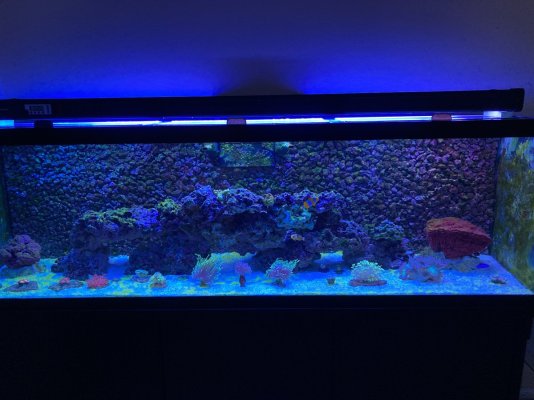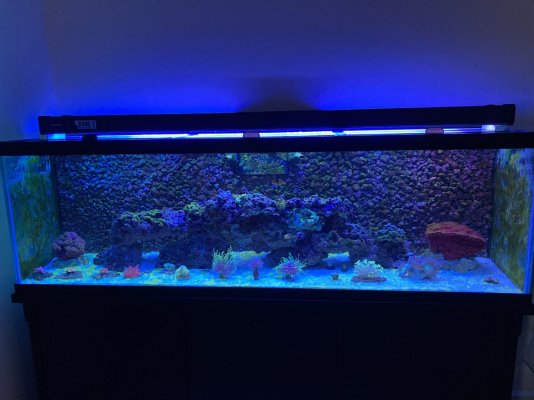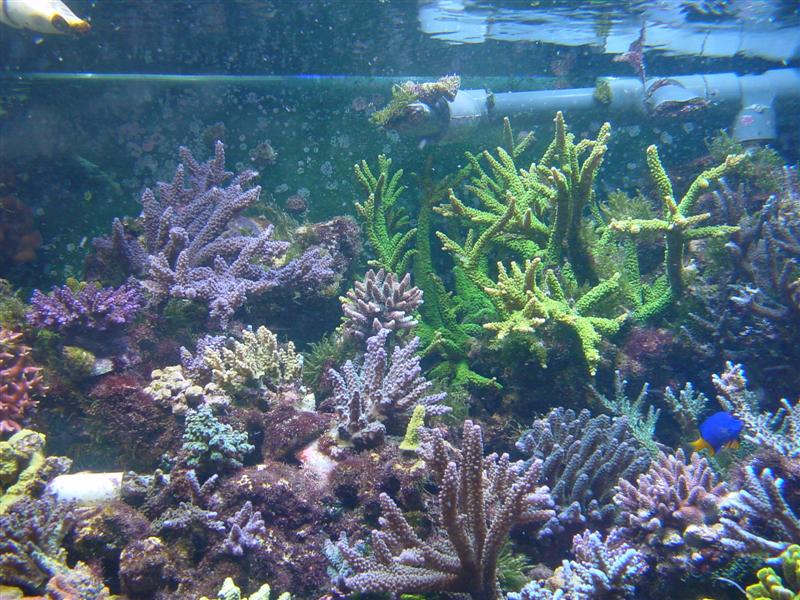I have not tried pushing through it yet, this time I think I will and see what happens. It's one of the only things I haven't tried...Meanwhile, I feed that much to my 5 fish in my 40 breeder twice a day — in addition to my nightly coral feeds.
po4: 0 (I dose neophos), nitrate 5-10.
Aquaforest probiotic method with 10% weekly water change, 30-40 lbs live rock, 1” sand, marinepure block, and 24/7 skimmer use.
Your bacteria populations will adjust to the nutrients present. If you suddenly start increasing nutrients, it’s going to take some time for the populations to stabilize assuming there are no limiting factors.
have you tried pushing through it?
Navigation
Install the app
How to install the app on iOS
Follow along with the video below to see how to install our site as a web app on your home screen.
Note: This feature may not be available in some browsers.
More options
You are using an out of date browser. It may not display this or other websites correctly.
You should upgrade or use an alternative browser.
You should upgrade or use an alternative browser.
Tank just won't stabilize
- Thread starter themericks
- Start date
- Tagged users None
- Status
- Not open for further replies.
If I was you, I would put all my corals and creatures into a separate container with the appropriate pump/circulation/heater to keep them comfortable., siphon all the sand out of the tank, and rinse it well in tank water until the water runs clear. It’ll probably take you a while to complete the job, but it is the solution to your problem. To tell the truth, I don’t even know if your sand can be salvaged after being abused like it’s been. You may need a new sand bed, but at least try to clean what you have. You’ll lose a lot of good bacteria if you have to change out your sand bed completely.Thanks, I am aware, that is why I started this thread. When I was siphoning, I was going down to the bottom glass, pulling out a ton of gunk out each time, and the sandbed looked much cleaner. Now that I've stopped siphoning, this is the result after a month.
- Joined
- May 13, 2017
- Messages
- 2,453
- Reaction score
- 1,280
Your not following along with what im saying. Doing small ones over an extended period allows the precipitation event to continue. It feeds it. Where as a couple of large ones stop the event by equalizing the parameters in rapid pace. Picture a fire burning and slowly throwing wood on it ( small water changes) vs the same fire with a large pile of wood thrown on it ( smothering the fire) large water change.If I do 3-5 gal a day for a week, that will equal a 20%. I am too nervous to do awc unless I'm home and too hard right now with work to do 1 large one. Will try this for 2 weeks and see if that works. Haven't dosed ca in 2 weeks.
- Joined
- May 13, 2017
- Messages
- 2,453
- Reaction score
- 1,280
This is drastic and unnecessary. The sandbed should get siphoned in sections with large water changes. Add in sand sifters, snails,fish,starfish ect. Increase flow, dose pods, and live phytoplankton. Once the sandbed has been siphoned stir those areas up every couple of days. That will help get the new detritus up into the water and out through filtration.If I was you, I would put all my corals and creatures into a separate container with the appropriate pump/circulation/heater to keep them comfortable., siphon all the sand out of the tank, and rinse it well in tank water until the water runs clear. It’ll probably take you a while to complete the job, but it is the solution to your problem. To tell the truth, I don’t even know if your sand can be salvaged after being abused like it’s been. You may need a new sand bed, but at least try to clean what you have. You’ll lose a lot of good bacteria if you have to change out your sand bed completely.
Good thing I wasn’t talking to you.This is drastic and unnecessary. The sandbed should get siphoned in sections with large water changes. Add in sand sifters, snails,fish,starfish ect. Increase flow, dose pods, and live phytoplankton. Once the sandbed has been siphoned stir those areas up every couple of days. That will help get the new detritus up into the water and out through filtration.
- Joined
- May 13, 2017
- Messages
- 2,453
- Reaction score
- 1,280
lol...Good thing I wasn’t talking to you.
@merickson45, I was just about to suggest adding more cuc, including some sand sifters. If you can find safe* nassarius snails (vibex or distortus- aka "Tongan"), these are extremely helpful.This is drastic and unnecessary. The sandbed should get siphoned in sections with large water changes. Add in sand sifters, snails,fish,starfish ect. Increase flow, dose pods, and live phytoplankton. Once the sandbed has been siphoned stir those areas up every couple of days. That will help get the new detritus up into the water and out through filtration.
I believe you said you have/had a lot of hair worms (the ones that don't live in tubes and have tentacles spread out in the sand)? If so, these are also helpful in removing extra food, waste, and other detritus but don't physically move the sand around much.
Most starfish, aside from some brittle stars, are not coral safe, so may not be the best choice.
Fighting conchs are also really good sand movers/sifters. (I see you said you have a tiger already)
You might also add a few Mexican turbo snails and additional ceriths (either the regular ones or the mini's), as they often will eat algae that other cuc won't, and ceriths also bury themselves and help with the sandbed.
*Regarding "safe" nassarius snails. In recent years, I have ordered what were sold as n. vibex but were actually predatory snails which quickly killed almost all the other snails in my tank. A lot of snails look very similar to the untrained (and even some trained) eyes, and we are all at the mercy of online vendors to select ones that only eat carrion.
Good luck. Please let us know how you make out. 
- Joined
- May 13, 2017
- Messages
- 2,453
- Reaction score
- 1,280
The sand sifting starfish are coral safe, almost always stay under the sand. Only issue is they work so well they can starve if there's not enough food .@merickson45, I was just about to suggest adding more cuc, including some sand sifters. If you can find safe* nassarius snails (vibex or distortus- aka "Tongan"), these are extremely helpful.
I believe you said you have/had a lot of hair worms (the ones that don't live in tubes and have tentacles spread out in the sand)? If so, these are also helpful in removing extra food, waste, and other detritus but don't physically move the sand around much.
Most starfish, aside from some brittle stars, are not coral safe, so may not be the best choice.
Fighting conchs are also really good sand movers/sifters. (I see you said you have a tiger already)
You might also add a few Mexican turbo snails and additional ceriths (either the regular ones or the mini's), as they often will eat algae that other cuc won't, and ceriths also bury themselves and help with the sandbed.
*Regarding "safe" nassarius snails. In recent years, I have ordered what were sold as n. vibex but were actually predatory snails which quickly killed almost all the other snails in my tank. A lot of snails look very similar to the untrained (and even some trained) eyes, and we are all at the mercy of online vendors to select ones that only eat carrion.
I’m sure the sand-sifting starfish are going to be very happy cleaning the rotten water that is in the OP’s sand bed. BTW. Water travels within the sand bed. So if you clean one section today, by tomorrow it will have rotten water in it again. Also, sand expires its usefulness, and if left in rotten water conditions for too long, needs to be changed. Google it.The sand sifting starfish are coral safe, almost always stay under the sand. Only issue is they work so well they can starve if there's not enough food .
Last edited:
Thanks to all who provided constructive suggestions, it's wonderful to be part of a respectful and knowledgeable community! I think I have a path forward for now, I'll try to be back in a month or so with an update.
- Joined
- May 13, 2017
- Messages
- 2,453
- Reaction score
- 1,280
The purpose for section cleaning is to minimize any shock to the system. Yes wTer travels in the sandbed with proper flow, detritus not so much though. Your lack of knowledge and experience is shining brightly.I’m sure the sand-sifting starfish are going to be very happy cleaning the rotten water that is in the OP’s sand bed. BTW. Water travels within the sand bed. So if you clean one section today, by tomorrow it will have rotten water in it again. Also, sand expires its usefulness, and if left in rotten water conditions for too long, needs to be changed. Google it.
Also, sand expires its usefulness, and if left in rotten water conditions for too long, needs to be changed. Google it.
Please explain how granules of rock and mineral "expire." I'm not a geologist and am genuinely curious.
- Joined
- Oct 17, 2018
- Messages
- 391
- Reaction score
- 556
To tell the truth, I don’t even know if your sand can be salvaged after being abused like it’s been. You may need a new sand bed, but at least try to clean what you have. You’ll lose a lot of good bacteria if you have to change out your sand bed completely.
You seem to think of sand in a strange way, as if it's something that expires, like GFO or activated carbon. There is really no such thing as sand expiring its usefulness.Also, sand expires its usefulness, and if left in rotten water conditions for too long, needs to be changed. Google it.
The sand in our tanks has been around for ever and ever. It's all old. The only thing that changes is the life that lives within it. If you take it all out and rinse it, you can call it "new" sand, but in reality it's still old. And if you rinse it well, then it's as relevant as it was the day it went into the tank.
Google “how often should you change your reef sand” and this is the first hit you get;You seem to think of sand in a strange way, as if it's something that expires, like GFO or activated carbon. There is really no such thing as sand expiring its usefulness.
The sand in our tanks has been around for ever and ever. It's all old. The only thing that changes is the life that lives within it. If you take it all out and rinse it, you can call it "new" sand, but in reality it's still old. And if you rinse it well, then it's as relevant as it was the day it went into the tank.
“Sand substrate is known to cause nutrient levels to rise over time, making it necessary to replace sand every two to five years.”
Try it.
The logic here is that the sand absorbs the nutrients from the crappy water, and then releases it when the nutrient level surrounding the sand, is less than the nutrient levels in the sand.
Last edited by a moderator:
I’d be curious to see a photograph of your tank. As it is today. Here’s mine:You seem to think of sand in a strange way, as if it's something that expires, like GFO or activated carbon. There is really no such thing as sand expiring its usefulness.
The sand in our tanks has been around for ever and ever. It's all old. The only thing that changes is the life that lives within it. If you take it all out and rinse it, you can call it "new" sand, but in reality it's still old. And if you rinse it well, then it's as relevant as it was the day it went into the tank.


Last edited:
Google “how often should you change your reef sand” and this is the first hit you get;
“Sand substrate is known to cause nutrient levels to rise over time, making it necessary to replace sand every two to five years.”
Try it.
The logic here is that the sand absorbs the nutrients from the crappy water, and then releases it when the nutrient level surrounding the sand, is less than the nutrient levels in the sand.
Again, what causes rocks and minerals to “expire?”
It’s rhetorical. It doesn’t. What does happen, is organics build up. Anaerobic pockets form, hydrogen sulfide is generated, and released when disturbed (to the detriment of livestock).
that’s not “bad sand,” it’s “dirty sand bed,” which are entirely different things.
though, if you could explain how inert inorganic material can go bad,” and cite reliable sources in the field of geology and chemistry, I’d love to hear it.
Last edited:
That's just the first hit. Read on and you'll find many more. Like this one.

The “Old Tank” Syndrome
Now that a tank no longer needs to be broken down and tanks are being maintained for long periods of time a new
Last edited by a moderator:
Again, what causes rocks and minerals to “expire?”
It’s rhetorical. It doesn’t. What does happen, is organics build up. Anaerobic pockets form, hydrogen sulfide is generated, and released when disturbed (to the detriment of livestock).
that’s not “bad sand,” it’s “dirty sand bed,” which are entirely different things.
though, if you could explain how inert inorganic material can go bad,” and cite reliable sources in the field of geometry and chemistry, I’d love to hear
The logic here, if you can manage to grasp it, is that the sand absorbs the nutrients from the crappy water, and then releases it when the nutrient level surrounding the sand, is less than the nutrient levels in the sandAgain, what causes rocks and minerals to “expire?”
It’s rhetorical. It doesn’t. What does happen, is organics build up. Anaerobic pockets form, hydrogen sulfide is generated, and released when disturbed (to the detriment of livestock).
that’s not “bad sand,” it’s “dirty sand bed,” which are entirely different things.
though, if you could explain how inert inorganic material can go bad,” and cite reliable sources in the field of geometry and chemistry, I’d love to hear it.
The logic here is that the sand absorbs the nutrients from the crappy water, and then releases it when the nutrient level surrounding the sand, is less than the nutrient levels in the sand, and since the sand is always surrounded by the crappiest water in the tank, it absorbs nutrients to a level equal to that crappy water. Think you understand now?
Last edited by a moderator:
- Status
- Not open for further replies.
Similar threads
- Replies
- 2
- Views
- 84
- Replies
- 2
- Views
- 230
- Replies
- 3
- Views
- 153

















